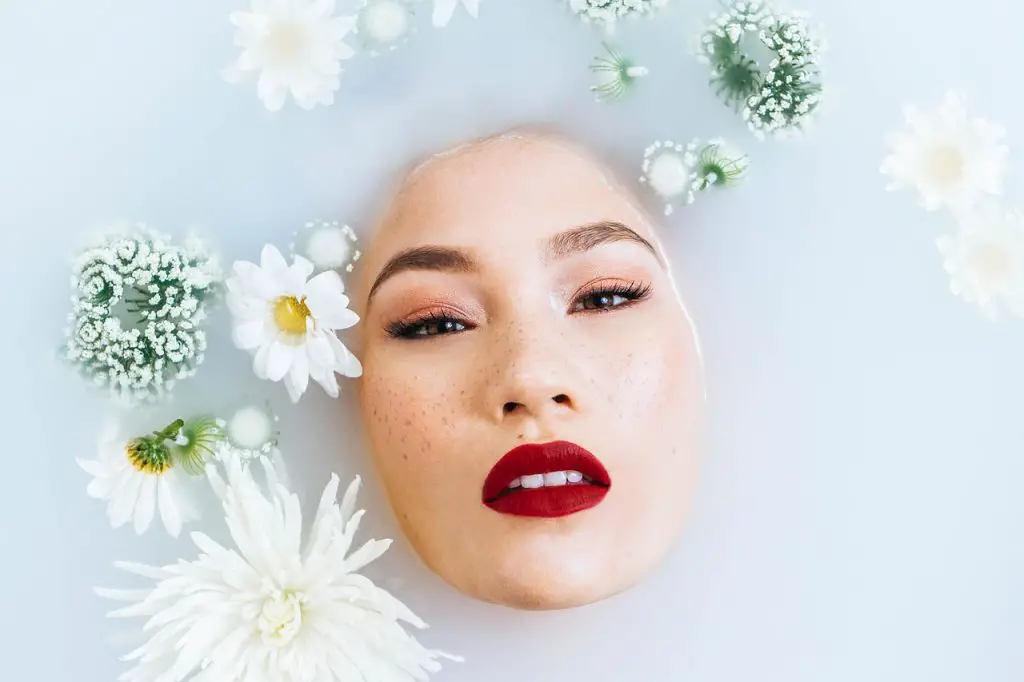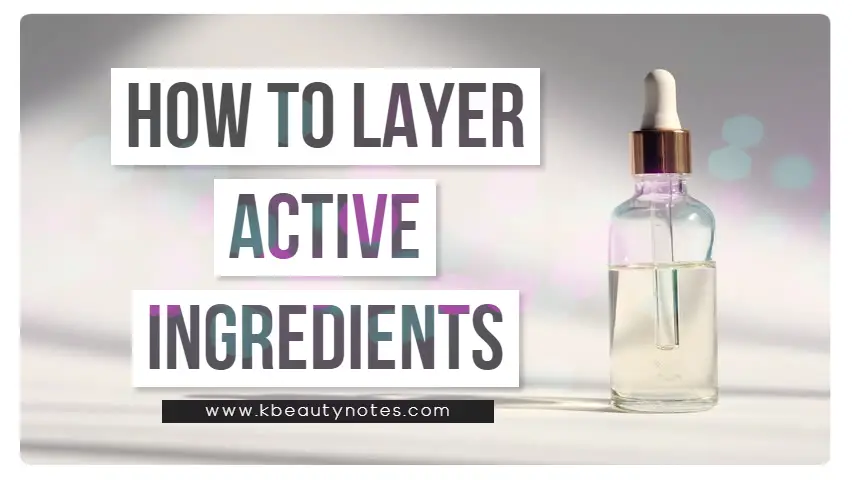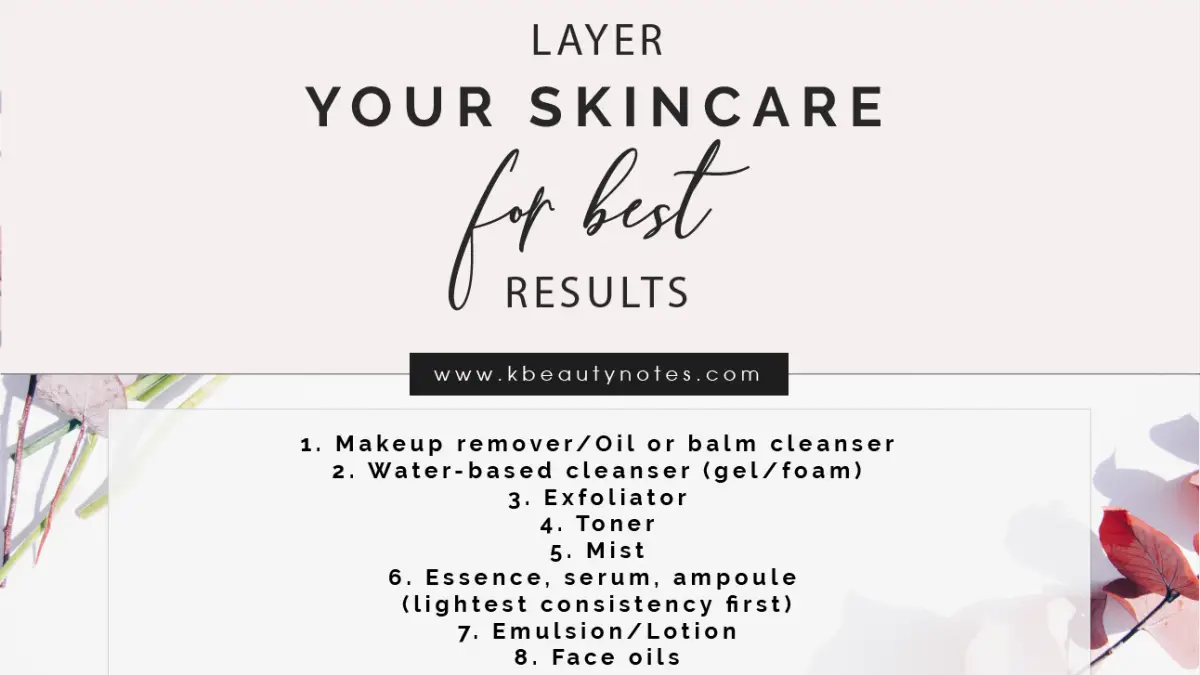If you’ve ever wondered if the order in which you apply your skincare matters, then the answer is: YES! The way you layer your skincare products it’s important in order for them to be effective and get maximum benefits.
How to layer skincare
- Makeup remover/Oil or balm cleanser
- Water-based cleanser (gel/foam)
- Exfoliator
- Toner
- Mist
- Essence, serum, ampoule
- Emulsion/Lotion
- Face oils
- Moisturizers/Creams
- Sunscreen
[*TIP: Thinner and drier oils (for oily skin types) can come before your moisturizer, heavier and more occlusive oils (for dry skin types) can come after moisturizer. Or better yet, you can MIX your oils with your moisturizer! ]
This is a general guide showing you the order in which each product should be applied. It doesn’t mean that you need to incorporate all 10 steps into your skincare routine. I personally have oily skin and I never find myself applying more than 4-5 products in the morning or evening. Otherwise my face will turn into a ball of grease.
The most simple and well known rule to follow is that products with the thinnest consistency should go first:
thinnest consistency —> thickest consistency (or liquid – waterbased to oil)
However, you’d want products (ingredients) that need to penetrate into the skin come before those that simply need to sit on top. Most of the time products are formulated in this way. Those that need to go first would be toners or serums with antioxidants like Vitamin C in liquid form and then we have face oils and moisturizers (occlusives) which have a thicker consistency.

Daytime vs Nighttime Routines
Skincare that you’ll use in the morning will be different from your evening routine which further simplifies the number of steps and products you need to use.
AM routine is all about sun protection and antioxidants, protection from pollution and environmental factors. Your routine in the morning may look something like this:
- Cleanser (It’s good to skip this if you could and wash your face only with lukewarm water, but for those of us with oily skin types it’s best to use a gentle cleanser.)
- Toner
- Serum with antioxidants – Vitamin C
- Eye cream (optional)
- Moisturizer (avoid oily moisturizers that stay on top of the skin)
- Sunscreen (Sunscreen always comes as the last step of skincare.
The correct order would be Skincare —> Sunscreen —> Makeup)
Since your skin repairs itself at night, your nighttime routine should be all about treatments and regeneration:
- Double cleanse (to remove makeup, sunscreen, dirt and oil)
- Toner or essence (or both, essences provide a more targeted treatment depending on your skin concern)
- Eye cream
- Treatment Serums/Creams (like AHAs/BHAs, retinol – Vitamin A, anti-aging serums with peptides, EGF).
*Do not layer all these together! - Face oil or cream mask
- Moisturizer to seal everything and prevent transepidermal water loss during the night.
Keep in mind that you don’t have to use some kind of skin treatment every single night, especially if your skin doesn’t need it. There are plenty of times where I would just hydrate my skin and go to bed. The overuse of treatments would increase the risk of irritation and we don’t want that. Which brings us to:

How to layer active ingredients
I wouldn’t recommend layering actives especially if you have dry (dehydrated with a compromised skin barrier – should focus more on repairing skin barrier) or sensitive skin. The last thing you’d want is to dry out your skin even more or cause irritation. So, try to use only 1 active at a time, for example:
- Vitamin C in the morning – AHA or BHA at night.
- Use them on separate days, Vitamin C one night, AHA or BHA the next.
Water soluble products should come before oil soluble ones.
- L-ascorbic acid (Vitamin C) – water soluble
- AHAs – water soluble
- Niacinamide – water soluble
- Alfa arbutin – water soluble
- BHAs – oil soluble
- Retinol – oil soluble
- Ceramides – oil soluble
You should know that just like we said that products should be applied in order of thinnest to thickest, they should also be applied from lowest to highest pH (water soluble products). The most acidic product goes on first! So, check the pH of your AHAs/BHAs or vitamin C should you choose to mix them.
If you want to layer your actives / ingredients, here is a list of dos and don’ts:
✔️ L-ascorbic acid (Vitamin C) + niacinamide – This has been debatable for such a long time but they’re safe to use together if your skin is not particularly sensitive. They do not cancel each other out.
✔️ Niacinamide + Vitamin B5 (Panthenol), Ceramides, Fatty Acids – Work really well together in repairing the skin barrier.
[ Vitamin B5 (Panthenol) + Madecassoside – This is also a great combination for restoring the skin barrier functions.]
✔️ Niacinamide + Retinol – Retinol has a track record of inducing irritation, but niacinamide can help decrease irritation and repair the skin barrier which makes it a great combination.
❌ AHAs/BHAs + Retinol – Do not use together. Risk of irritation and over-exfoliation!
❌ L-ascorbic acid (Vitamin C) + Retinol – Irritation. It’s best to use Vitamin C in the morning and Retinol at night.
✔️ AHAs + BHA – AHAs are water soluble and they exfoliate the surface of the skin, while BHA which is oil soluble – more suitable for oily skin, can get deep into the pores. Many products on the market contain both in their formulas.
✔️ AHAs + L-ascorbic acid (Vitamin C) – Layer at nighttime. AHAs/BHAs make the skin more acidic due to their low pH which creates optimal conditions for the vitamin C to be effective. Sensitive skin types should avoid this combo. (Check the pH of your products!)
✔️ Vitamin C + Vitamin E – By using Vitamin C and E together you’re giving your skin double the antioxidant benefits to fight damage from free radicals and UV damage.
If you have the skin concerns I mentioned earlier such as dry or sensitive skin, compromised skin barrier, please approach ingredient layering with caution. Every skin type is different and will react differently so make sure that your skin would tolerate some of these combinations that may cause irritation due to their low pH formulas. Always patch test before applying to your entire face!
What does your routine look like? Do you layer your skincare products in the correct order? Do you have any favorite active ingredient that you can’t do without? 🤩 Please share your thoughts or questions in the comments! XO
Also Read:
Mandelic Acid 5% Skin Prep Water By Wishtrend Review – (AHA)
Klairs Freshly Juiced Vitamin C Drop Review – (Vitamin C)
The Ordinary Niacinamide 10% + Zinc 1% Review – (Niacinamide)
Related posts
TIAM Vita B3 Source Review
Skin&Lab Retinol Repair Serum Review
5 Comments
Leave a Reply Cancel reply
Follow blog via Email
Get the latest posts from this blog delivered to your inbox!
About Me
Hi and welcome to Kbeauty Notes! :)
I’m Ledia and I’m very passionate about everything skincare. I created this blog to share my thoughts and experience with many amazing and not so great products out there, hoping to help you make better decisions regarding your skin.
I’m very happy to bring you on this journey with me and I hope you enjoy it! <3
My Skin Type: Oily, acne prone, dehydrated, a little sensitive, large pores.
Skincare Concerns: hydration, pore care, anti-ageing, PIE (acne marks), brightening.
Contact: kbeautynotes@gmail.com





These are great tips. Personally, my rule is just double cleanse and use the products from thinnest to thickest formulas.
xx Alyssa | STYLE VANITY
Hi can i know how to use two different essence.. One is more like watery and the other one is like gel.. Thank you in advance ☺
Hi Kina! You can use the one that is watery first and then the one that’s in gel form. xx
I have dry acne prone skin, want to use salicylic acid active in my routine. please suggest beginner friendly acid
Salicylic acid (BHA) can be a bit drying for dry skin. Is it acne you want to tackle? In that case maybe give a try to AHAs or Niacinamide.